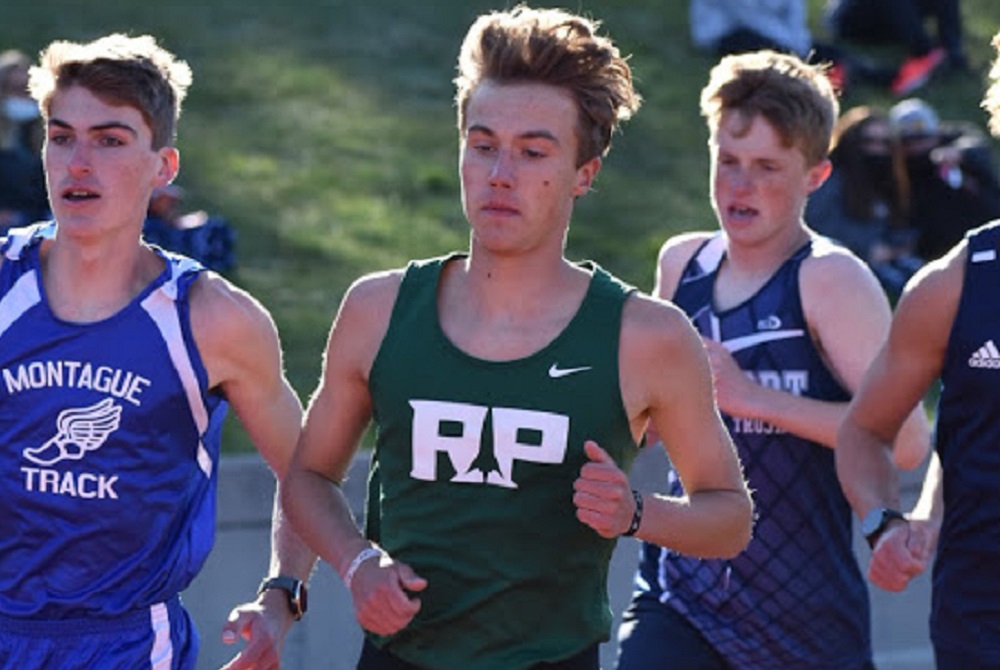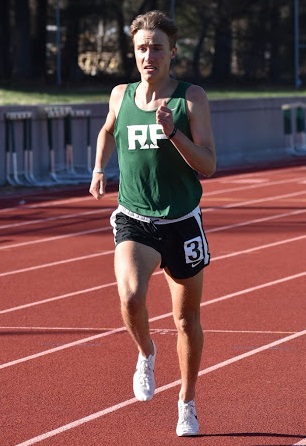
Reeths-Puffer ‘Ironman’ Slows Down to Help Team Surge
By
Tom Kendra
Special for MHSAA.com
May 6, 2021
Klay Grant’s strategy going into last week’s Greater Muskegon Athletic Association city track meet seemed, at first, counterintuitive.
 “My plan was to try and run each event as slow as possible,” said Grant, a junior at Muskegon Reeths-Puffer, before adding:
“My plan was to try and run each event as slow as possible,” said Grant, a junior at Muskegon Reeths-Puffer, before adding:
“And still win.”
His plan to conserve energy – essentially sacrificing fast times for himself to try and gather as many points as possible for his team – worked to perfection as Grant became the first athlete in the 65-year history of the GMAA meet to take first place in the four longest events.
Grant’s “Ironman” performance and four first-place finishes accounted for 40 of his team’s 132 points, helping the Rockets edge six-time reigning champion Fruitport and win the meet for the first time since 2006.
Grant started his record-breaking night by running the anchor leg on R-P’s winning 3,200-meter relay team (8:40.84), then followed with wins in the open 1,600 (4:42.94), 800 (2:07.25) and 3,200 (10:29.69).
“Klay is all about the team,” explained Reeths-Puffer boys track coach Don Ketner, who is in his 15th year. “He’s the kind of kid that would give the shirt off of his back for you, and that’s basically what we asked him to do on Friday night.”
The GMAA Meet, known locally simply as the “City Meet,” dates back to the 1950s, and during its long history many male and female athletes have won four events. However, that feat normally happens with sprinters in short events and relays or with an athlete who picks up a win or two in the field events before the running finals begin.
Grant was the first to capture all four of the longest running events, but he said that individual feat was secondary. He said the best part was helping to deliver a memorable night for Reeths-Puffer, as his family is heavily invested in the Muskegon County school district and its track & field and cross country programs.
Both of his parents, Darren and Angie Grant, are Reeths-Puffer graduates and runners who went on to run in college at Indiana Wesleyan and now teach and coach in the R-P district. Darren Grant, who teaches fifth grade, is the Rockets’ head cross country coach and assistant boys track coach. Angie Grant teaches special education at the middle school and is the head girls track coach.
 “It was fun to be a part of such a great night,” said Grant, 17, who plans to go into the ministry and pursue Biblical studies in college. “Faith encompasses everything that I do, so it felt great to use my gifts to help out my teammates and coaches.”
“It was fun to be a part of such a great night,” said Grant, 17, who plans to go into the ministry and pursue Biblical studies in college. “Faith encompasses everything that I do, so it felt great to use my gifts to help out my teammates and coaches.”
Grant, who is also laser-focused in the classroom with a gaudy 4.333 GPA, is the third of four children. His older siblings are Cole and Kenna, and younger brother Kye is a talented runner on the Reeths-Puffer middle school team.
While running has always been a part of his life because of his parents, his primary sport growing up was soccer. In fact, it wasn’t until last year that he focused exclusively on track and cross country, which is why he believes he can greatly improve his times.
Perhaps the key race of the entire GMAA meet last week was the opening 3,200-meter relay, which Fruitport was favored to win. Ketner gambled that by putting Grant on the anchor leg, he might be able to catch up and pass Fruitport.
As it turned out, strong performances on the first three legs by freshmen Jackson Allen and Tate Bradley and senior Caden Tufts had the Rockets in the lead when Grant got the baton – allowing him to cruise to the tape and make a major statement in the process.
Grant then had a nice stretch of time to rest before his next race, the 1,600, but that was the first of three long races over a short period of time.
After pulling away from Jackson Helmer of Mona Shores in the 1,600, Grant had just three events of rest before getting back on the track for the 800 – the event he will likely focus on for the upcoming Ottawa-Kent Conference Green meet May 13 and the Division 2 Regional on May 20.
Then came the shortest turnaround of the night, with just the quick 200-meter run coming between the 800 and the 3,200.
Grant knew he could empty the tank in the 3,200, and it didn’t take long for Grant and his senior teammate and training partner Brett Schlaff to separate themselves from the rest of the field. With those two running 1-2 ahead of the pack, it was clear that the Rockets would pick up 18 points in that event and clinch the meet title.
The only drama remaining was whether Grant would make history or if the fresher Schlaff would prevail.
“With about 300 meters to go they were still close and I said out loud: ‘Klay is so nice, he’s going to let Brett win,’” said Ketner.
Grant ended up pulling away over the final 200 meters to win the race and make history. Schlaff took a strong second, and the Rockets were on top of the Muskegon city track world for the first time in 15 years.
“My times were nothing special that night, that’s for sure,” said Grant. “But this meet wasn’t about me. This meet was all about the team.”
 Tom Kendra worked 23 years at The Muskegon Chronicle, including five as assistant sports editor and the final six as sports editor through 2011. E-mail him at [email protected] with story ideas for Muskegon, Oceana, Mason, Lake, Oceola, Mecosta and Newaygo counties.
Tom Kendra worked 23 years at The Muskegon Chronicle, including five as assistant sports editor and the final six as sports editor through 2011. E-mail him at [email protected] with story ideas for Muskegon, Oceana, Mason, Lake, Oceola, Mecosta and Newaygo counties.
PHOTOS: (Top) Klay Grant (1) competes in the 800-meter run at the Rocket Invitational on April 16 at Reeths-Puffer. Grant won the race. (Middle) Grant cruises to victory in the 1,600-meter run at the GMAA city meet. (Photos by Payden Challinor.)

Hastings Relays Reigns as State's Oldest Continuous Track & Field Meet
By
Steve Vedder
Special for MHSAA.com
April 10, 2024
Bob Branch remembers dabbling in other sports, but his first love was always running.
 The Hastings High School graduate admits he could never hit a baseball, football didn't especially appeal to him and basketball was just another way to spend time with friends. But for Branch, now 93, there was always track. That's the sport where his fondest and sharpest memories remain. And if you're talking track, many of his favorite memories come from participation in the state's oldest continuous track meet, the Hastings Relays.
The Hastings High School graduate admits he could never hit a baseball, football didn't especially appeal to him and basketball was just another way to spend time with friends. But for Branch, now 93, there was always track. That's the sport where his fondest and sharpest memories remain. And if you're talking track, many of his favorite memories come from participation in the state's oldest continuous track meet, the Hastings Relays.
Always held in early April, the meet dates back to 1937 – a bygone time that saw the first hostilities of World War II, gas at 20 cents a gallon and a loaf of bread selling for a dime.
And at a dusty old track surrounding the county fairgrounds in Hastings, a small relay event that included a scattering of participants from a dozen high schools was taking its first tentative steps.
Branch recalls a time when kids would run home after track practice because there were no buses, inexperienced young coaches had little actual knowledge of running fundamentals, and athletes looked at the sport as an afterthought after spending most of their high school days playing football and basketball.
 For Branch, the relays were the ideal way to ease into the track season.
For Branch, the relays were the ideal way to ease into the track season.
"I just liked to run," said Branch. "I remember I anchored a relay with my brother, and it always seemed cold when we had that meet. I remember teams would come from all over and you saw a lot of good athletes. Everybody seemed to have someone who was really good. Track wasn't very popular at that time, but I have a lot of good memories from running."
The Hastings Relays, which has changed formats and even names during its nearly nine-decade history, would traditionally kick off the track season. The meet was originally held at a makeshift quarter-mile track which surrounded the town's fairgrounds and was part of the city's annual Hastings Carnival – the track would become the midway during fair time.
The meet eventually moved to Johnson Field when the football field was dedicated in 1949 and ballooned to as many as 50 teams at its peak in 1957. For more than seven decades it was known as the Hastings Relays and then the Hastings Co-Ed relays before becoming the current Hastings Invitational, with the latest edition scheduled for Friday.
Johnson Field had a cinder track before it became an all-weather surface in the 1980s. During a time long before computers would be used to organize meet heats in mere minutes, Hastings coaches of all sports – defined as "volunteers" by the athletic department – would meet on the Friday before competition to hash out events.
People associated with the meet still recall the camaraderie built on those long Friday nights, followed by working what would often become 10-hour meets. Steve Hoke has been involved since watching his father, Jack, who coached teams at 15 of the meets beginning in 1951 and also had run in the first Hastings Relays. Steve Hoke later competed in the Relays as well during the early 1970s before becoming an assistant track coach, later the Hastings athletic director and now a volunteer worker.
"It was always a huge deal," said Hoke, who said the meet began as a pure relay event before transitioning to its current team format in the 1990s. "I remember we'd line the track the night before, and all the coaches would come to the house to organize everything. There was a brotherhood.”
 If you quiz many of the fleet of volunteers who've worked the relays over the years, each has a different memory from the meet. While Hoke describes the brotherhood and Branch the outstanding competition, others remember weather and the time a thunderstorm wiped out the line markings on the cinder track, or waking up to find three inches of snow that caused a rare cancellation of the meet. Others recall the shock of moving from the cinder to all-weather track or using the meet as an early measuring stick of what it would take to qualify for the state meet. The real old-timers remember the meet disappearing for three years during World War II.
If you quiz many of the fleet of volunteers who've worked the relays over the years, each has a different memory from the meet. While Hoke describes the brotherhood and Branch the outstanding competition, others remember weather and the time a thunderstorm wiped out the line markings on the cinder track, or waking up to find three inches of snow that caused a rare cancellation of the meet. Others recall the shock of moving from the cinder to all-weather track or using the meet as an early measuring stick of what it would take to qualify for the state meet. The real old-timers remember the meet disappearing for three years during World War II.
Hastings native and Western Michigan grad Tom Duits was the state’s second collegian to break the four-minute mile when he ran a 3:59.2 at a meet in Philadelphia in 1978. Duits, who ran in three Hastings Relays, was in line to join the U.S. Olympic team in 1980 before the United States pulled out of the games due to tension with Russia.
Duits has his own memories of the meet and the competition he faced there.
"I remember sunshine and being excited to be competing again. There were all these athletes swarming around; it was an awesome display of talent," he said. "It was always one of the best meets we'd be in. You could pretty much see the level of runners who would be at state, which made it a big deal. It was always early, but you could tell where you stood. It was great exposure."
Hastings track star Wayne Oom competed in four Hastings Relays from 1984-87. One of his sharpest memories was the difference between running on a raw cinder track versus the far more comfortable all-weather surface.
"Those cinders would grind into your skin," said Oom, part of the Hastings school record in the two-mile relay. "But I think it helped us because when we'd go to other tracks, it seemed we would run faster. I remember how competitive it was, especially in the distances. There were some great runners."
While participants have their unique memories, so do coaches. Former Saxons coach Paul Fulmer remembers 2008 when his team finished first on the boys side of the meet while his wife, Grand Haven coach Katie Kowalczyk-Fulmer, saw her girls team win the championship.
 "I knew we were one of the favorites to win because we were usually near the top of our conference and Regional," he said. "But then Katie's team was pretty good, and it was cool for them to win too."
"I knew we were one of the favorites to win because we were usually near the top of our conference and Regional," he said. "But then Katie's team was pretty good, and it was cool for them to win too."
Fulmer, who coached Hastings from 1978-81 and then 1985-2010, said at least part of the meet's popularity was derived from a unique way of scoring. Instead of individuals earning points solo, participants worked in pairs. For instance, two athletes would combine their shot put or long jump scores. New events such as the 1,500 relay and sprint medley were added.
"We had a tradition of being the state's oldest meet, and that was a big deal," Fulmer said. "And we ran a good relay; that attracted teams too. We took a lot of pride in that.
"And we'd get quite a lot of people to come to the meet. We'd set up until like 9 or 10 p.m., and then we'd have a party with all the coaches on Friday night."
While the meet has stretched 87 years, Branch said early participants and current runners have one thing in common: a drive to win. Branch ran in an era when the popularity of high school track was in its infancy. Today some of the best all-around athletes at a school are involved in the track program. The relays span the nearly nine decades in between.
"The quality of teams has gotten better and better," said Branch, the 1947 Lower Peninsula Class B Finals champ in the 220. "And this has made for a better meet. We would get guys who played football or baseball kind of drift into track, and that made the sport better. I think people began to appreciate track because we'd get teams from all over.
"We went from not really knowing what we were doing to track being a good sport. Even then, I'm not sure we appreciated what we had. We really liked the Hastings Relays and always wanted to do well there. It became popular and quite an honor to do well. Those are the kind of things I remember."
PHOTOS (Top) Racers run at the Hastings Relays, with several more awaiting their turns to compete at the longtime meet. (2) The author wrote on the 50th anniversary of the Relays for the Hastings Banner nearly 40 years ago. (3) Past athlete, coach and athletic director Steve Hoke shows some of the Relays awards from the 1930s. (4) Tom Duits was one of the state’s biggest track stars of the 1970s and ran in three Hastings Relays. (Top photo by Dan Goggins, Hoke photo provided by Steve Hoke and Duits photos provided by Tom Duits.)

